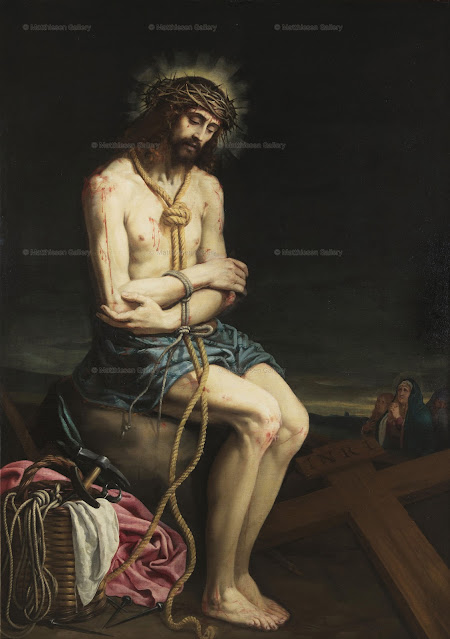 |
| Jacquemart and Workshop, Jesus Is Stripped of His Garments From the Grandes heures de Jean de Berry French (Paris), c. 1409 Paris, Bibliotheque nationale de France MS Latin 919, fol. 70r |
All four Evangelists indicate that, before being nailed to the cross, the garments worn by Jesus were removed. This makes sense. In an era where every item of clothing was handmade, garments were relatively valuable. It didn’t do to waste them, even if worn and bloodstained.
Furthermore, stripping the victim before
crucifixion was a further humiliation and, for Jews an especially horrifying
one. Public nudity in the gymnasium had
been one of the causes of the Maccabee rebellion against the Hellenized
Seleucid dynasty about 200 years previously (1 Maccabees: 14-15).
 |
| Jesus Is Stripped of His Garments French, 15th-16th Century Wissembourg, Church of Saints Peter and Paul |
 |
| Jesus Is Stripped of His Garments From Speculum animae (in Catalan) Spain (Valencia), c. 1475-1500 Paris, Bibliotheque nationale de France MS Espagnol 544, fol. 33v |
 |
| Guillaume Hugueniot, Jesus Is Stripped of His Garments From Hours of Pierre de Bosredont French (Langres), c. 1460-1470 New York, Pierpont Morgan Library MS G 55, fol. 128r |
However, John
modifies this somewhat to say that they divided most of the clothing up into
four equal parts, and cast lots only for the tunic which was woven in one piece
(John 19:23-25).
This part of the Passion narrative has not received much
artistic attention. I was able to find
only a handful of images showing Jesus being disrobed. The earlier images tend to portray the
violence of the encounter of Jesus with the guards who strip him.
 |
| El Greco, Jesus Is Stripped of His Garments Greco-Spanish, c. 1600 Budapest, Szépmûvészeti Múzeum |
 |
Anonymous, Jesus Is Stripped of His Garments French (Amiens), c. 1600-1640 Amiens, Musée de Picardie In this image Jesus is being stripped at the same time as He is being nailed to the cross. |
 |
| Frans Francken II, Jesus Is Stripped of His Garments Belgian, 1620 Private Collection At the right soldiers are pulling off His clothing |
 |
| Giandomenico Tiepolo, Jesus Is Stripped of His Garments From Stations of the Cross Italian, 1749 London, British Museum |
 |
| Giovanni Battista Loreti, Jesus Is Stripped of His Garments Italian, 1758 Fabriano, Church of Santa Lucia |
Later images tend to focus more on the
resulting display of naked flesh.
 |
Mattheus Ignaius van Bree, Jesus Is Stripped of His Garments Belgian, 1820 Private Collection |
 |
| Bernard Naudin, Jesus Is Stripped of His Garments French, 1936 Paris, Centre national d'art et de culture Georges-Pompidou |
Christ on the Cold Stone
In addition, during the sixteenth and seventeenth centuries,
artists from the Netherlands (including modern day Belgium) produced a series
of unusual images, known in English as “Christ On the Cold Stone”. These devotional images show the disrobed figure of
Jesus seated on a stone. The original
intent seems to have been to show Jesus midway between the end of his journey
to Calvary and his actual nailing to the cross. To this end He is shown seated at Calvary or
at least outdoors.
 |
Pseudo Jan Wellens de Cock, Calvary Dutch, c.1520 Amsterdam, Rijksmuseum |
 |
| Circle of Joos van Cleve, Christ on the Cold Stone with Donor Flemish, c. 1520-1530 Private Collection |
However, the similarity of this image to that of the Man of Sorrows 1 quickly overwhelmed the original intent and the background of the image became less and less specific until any suggestion of an outdoor setting is gone.
 |
Jan Gossart, Christ On the Cold Stone Flemish, 1527 Budapest, Szépmûvészeti Múzeum |
 |
Jan Gossart, Christ On the Cold Stone Flemish, c.1530 Valencia, Colegio Real del Corpus Christi |
 |
Cornelis Corneliszoon van Haarlem, Christ On the Cold Stone Dutch, 1600 Private Collection |
 |
Hendrik de Clerck, Christ On the Cold Stone Flemish, c.1600 Private Collection |
 | |
|
 |
| Anonymous, Christ on the Cold Stone Flemish, First Half of 17th Century Private Collection |
 |
| Vicenete Carducho, Christ in Comtemplation on the Cold Stone Spanish, c. 1625-1650 Private Collection |
 |
Gaspar de Crayer, Christ On the Cold Stone With Two Angels Flemish, c. 1649-1656 Private Collection |
This image enjoyed some popularity from the
beginning of the sixteenth century till about the middle of the seventeenth and
disappeared thereafter.
© M. Duffy, 2016. Updated and additional images added 2023.
__________________________________________________________________
1. The chief
difference between the two similar images is that in “Christ On the Cold Stone”
Jesus is as yet unmarked. He has not yet
been nailed to the cross and therefore his hands, feet and side are whole. The “Man of
Sorrows”, on the other hand, shows Jesus with the nail holes and pierced side. For the “Man of Sorrows”, please see http://imaginemdei.blogspot.com/2012/04/meditation-on-passion-man-of-sorrows.html
* For the Ninth Station, see: Stations of the Cross: Jesus Falls, The Third, Seventh and Ninth Stations
Scripture texts in this
work are taken from the New American Bible, revised edition© 2010,
1991, 1986, 1970 Confraternity of Christian Doctrine, Washington, D.C. and are
used by permission of the copyright owner. All Rights Reserved. No part of the
New American Bible may be reproduced in any form without permission in writing
from the copyright owner.







No comments:
Post a Comment